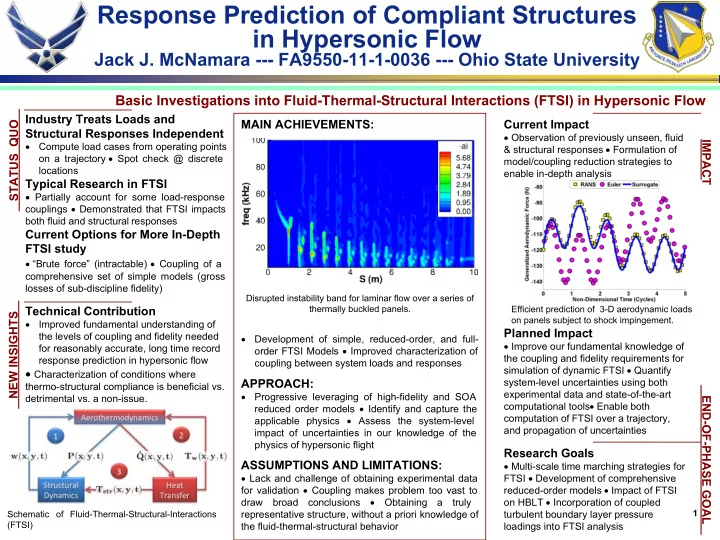

Response Prediction of Compliant Structures in Hypersonic Flow Jack J. McNamara --- FA9550-11-1-0036 --- Ohio State University Basic Investigations into Fluid-Thermal-Structural Interactions (FTSI) in Hypersonic Flow STATUS QUO Industry Treats Loads and MAIN ACHIEVEMENTS: Current Impact Structural Responses Independent Observation of previously unseen, fluid IMPACT Compute load cases from operating points & structural responses Formulation of on a trajectory Spot check @ discrete model/coupling reduction strategies to locations enable in-depth analysis Typical Research in FTSI Partially account for some load-response couplings Demonstrated that FTSI impacts both fluid and structural responses Current Options for More In-Depth FTSI study “Brute force” (intractable) Coupling of a comprehensive set of simple models (gross losses of sub-discipline fidelity) Disrupted instability band for laminar flow over a series of NEW INSIGHTS thermally buckled panels. Technical Contribution Efficient prediction of 3-D aerodynamic loads on panels subject to shock impingement. Improved fundamental understanding of Planned Impact the levels of coupling and fidelity needed Development of simple, reduced-order, and full- Improve our fundamental knowledge of for reasonably accurate, long time record order FTSI Models Improved characterization of the coupling and fidelity requirements for response prediction in hypersonic flow coupling between system loads and responses simulation of dynamic FTSI Quantify Characterization of conditions where APPROACH: system-level uncertainties using both thermo-structural compliance is beneficial vs. END-OF-PHASE GOAL experimental data and state-of-the-art Progressive leveraging of high-fidelity and SOA detrimental vs. a non-issue. computational tools Enable both reduced order models Identify and capture the computation of FTSI over a trajectory, applicable physics Assess the system-level and propagation of uncertainties impact of uncertainties in our knowledge of the physics of hypersonic flight Research Goals ASSUMPTIONS AND LIMITATIONS: Multi-scale time marching strategies for Lack and challenge of obtaining experimental data FTSI Development of comprehensive for validation Coupling makes problem too vast to reduced-order models Impact of FTSI draw broad conclusions Obtaining a truly on HBLT Incorporation of coupled representative structure, without a priori knowledge of turbulent boundary layer pressure 1 Schematic of Fluid-Thermal-Structural-Interactions (FTSI) the fluid-thermal-structural behavior loadings into FTSI analysis
Structural Responses at High Speeds Exhibit Strong Sensitivities to Varying Characteristics of Boundary Layer Turbulence Dr. Jack Panel response, McNamara as measured by Associate Professor center point • Mechanical & displacement, Aerospace varies widely with Engineering different models • Senior for boundary layer Member AIAA turbulence 1 . • 2011 Recipient of AFOSR YIP Award •2014 – 2015 Defense Science Study 1 Deshmukh, R., McNamara, J., and Culler, A., “Response of Skin Panels to Combined Self and Boundary 2 Group Layer Induced Fluctuating Pressure, AIAA-2013-1744.
New CFD Surrogate to Enable First Comparison with AFRL Experiment Studying Shocks Impinging on Compliant Surfaces Surrogate shows excellent agreement with actual CFD prediction of 3D flows with shock impingements 2 120 seconds of thermo-structural response - CFD surrogate:8 hours on one core; actual (RANS) analysis:217,000 hours on 94 cores (@ ~100,000 cells/core). 2 Crowell, A. “Model Reduction of Computational Aerothermodynamics for Multi-Discipline Analysis in High Speed Flows,” Ph.D. 3 Thesis , The Ohio State University, 2013.
Heilmeier's Catechism Your Highlight Should Answer the Red Questions – green (2 nd priority) and black (3 rd priority) questions are nice, but optional by George H. Heilmeier, President and CEO of Bellcore • What are you trying to do? Articulate your objectives using absolutely no jargon. • How is it done today, and what are the limits of current practice? • What's new in your approach and why do you think it will be successful? • Who cares? If you're successful, what difference will it make? • What are the risks and the payoffs? • How much will it cost? How long will it take? • What are the midterm and final "exams" to check for success? Additionally… • Does this work address the objectives of the portfolio to which it is being submitted? • Are there opportunities to collaborate with other efforts – both internally and externally? 4
Recommend
More recommend